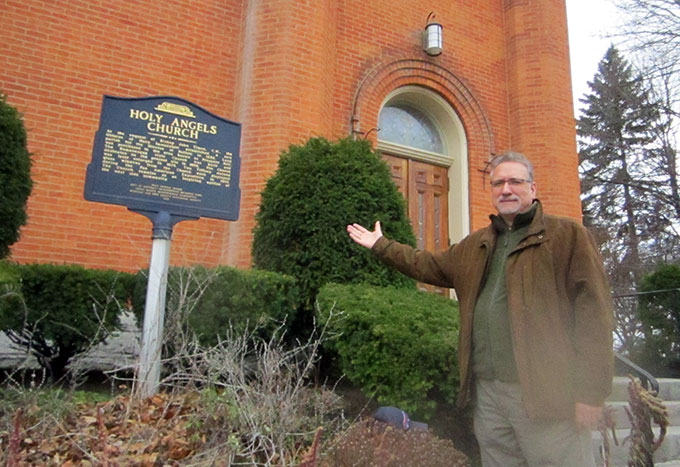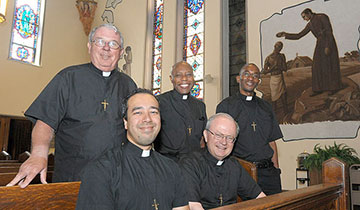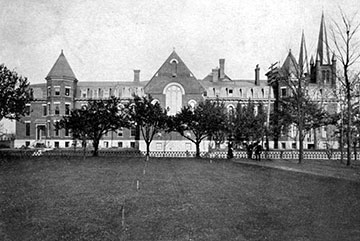The Mass Mob movement energizes the Catholic Church
by Alan Oberst



Buffalo Mission Mob
Believe it or not, it’s been just over a year since the first Buffalo Mass Mob, initiated by Chris Byrd of Broadway-Fillmore Alive, which took its inspiration, in part, from Chris Smith’s Buffalo Cash Mob for small business. As one of the four Buffalo Mass Mob organizers (the other two being Greg Witul and Danielle Huber), I can attest that it’s been kind of a wild ride. Going viral, the Mass Mob movement has garnered national and international attention, including October features on NPR and on the front page of the New York Times, inspiring people in other cities to organize their own. Over a thousand people attended September’s Buffalo Mass Mob at Assumption Church in Black Rock. Over the last year, the effort has also raised over $30,000 for the churches it has visited. Mass Mobs in Detroit and Hamtramck have drawn as many as two thousand participants.
Along the way, the Mass Mob has found itself part of a lively, urgent discussion in the Catholic Church (and in most denominations) about the relevance and vitality of churches in 21st Century America. In modern, highly secularized America, what is the mission of the church? Not only at the grass roots: the Pope, Cardinals, and Bishops have discussed the same at this year’s oft-contentious Vatican synod.
One answer, from the Oblates of Mary Immaculate (OMI), the religious order that founded Holy Angels Church in the 1850s (almost simultaneously with the “Grey Nuns” founding of neighboring D’Youville College) as a mission to Buffalo’s newly arrived Catholics, is to return to their roots by establishing actual, literal, missions. Buffalo is fortunate that Holy Angels was recently designated as one of four such missions nationwide by OMI. Fortunate indeed, because otherwise, local Oblates told me last week, Holy Angels—the mother church of the West Side—seemed headed for closure.
According to the Oblates’ own website, “Holy Angels holds the distinct honor of hosting the longest continuous presence of the Oblates in the United States.” But their work of over 160 years—spanning nearly the entire existence of their order, which celebrates is bicentennial in 2016—was far from done. Buffalo’s West Side still needs the Oblates, even if not in the same way.
“That’s why we decided to stay in Buffalo,” Oblate Father Bouzi told WNY Catholic, the monthly newspaper of the Buffalo Diocese. “The West Side is changing. There are a lot of refugees, a lot of poor people living here on the West Side of Buffalo. We decided to work here on the West Side.” Oblate Father Roque added, “we work where there is a need. That’s who we minister to as Missionary Oblates, those people on the sides because they are newly arrived; they don’t understand, they’re lost. That’s our work. Our energies go there.”
The new national structure around “missions” is also fortunate for OMI, whose numbers had dwindled and grown dispersed around the country in recent years. The Oblates at Holy Angels told me they see it as “a way to revitalize both the Oblate community and the communities they work in.” It also marks a return to the original OMI model, where Oblates would establish a mission house as a base of operations to minister in the community, as they originally did in 19th Century Buffalo.
One immediate and visible result is to re-enliven the corridors and grand spaces of Holy Angels parish. At any given time, now, there are four to eight priests, who minister to Holy Angels parish, the other two west side parishes also now overseen by the Oblates, Holy Cross and Our Lady of Hope, and the surrounding community. Joining the Oblates—who are housed together, pray together, and eat together—are six initiates, who spend a year working with the Oblates, and attending classes at D’Youville College. The Oblates also train lay associates who work side-by-side with them, such as eight-decade neighborhood resident Robert Chambers, a former principal of Bishop Timon High School whose great-grandparents were among the first to be married at Holy Angels.
And what will the Oblates, initiates, associates, and other lay helpers be doing in the community? “Through community discernment and consensus, the Oblates will go beyond the institution by serving in a variety of other ministries—campus, prison, youth, homeless, immigrant groups, itinerant mission preaching, education, community organizing, vocation. These centers will continue to evolve to deal with their local communities,” the Oblates told WNY Catholic. They have been working with Catholic Charities to assist refugees, and have also connected with social justice organization Voice Buffalo, they told me last week.
And significantly, the Oblates also have the massive responsibility to care for not only the spiritual needs of the three linked West Side parishes, but also their buildings. These are almost all old buildings, many over a century old, and cost a lot to maintain and heat in the winter. Although it should be noted that Holy Angels has fewer buildings than it used to. It’s former academy was nicely adapted to become D’Youville College’s library, and an earlier school building that once used to stretch nearly half a block along Fargo, burned long ago (the 1940s rectory now occupies part of that site). For the time being, the Oblates told me, they have an “angel,” someone very adept at dealing with their building needs.
In addition to wanting to help share the good news about the Oblates remaining, and even expanding their role in Buffalo, it was also the opportunity to show the community one of the inspiring buildings that they have the massive responsibility to care for—and heat—that drove interest in this month’s Mass Mob at Holy Angels. The community responded by filling the church and giving generously. “Bring your envelopes!” said a neighborhood resident, in an email to friends about the Mass Mob.
What the Oblates are doing on the West Side suggests that, to be relevant in the modern world, the Church should harken back to its earliest roots: ministering to the needs of the community, as the community supports the needs of those who minister to them. It is right and just.
blog comments powered by Disqus|
Issue Navigation> Issue Index > v13n50 (Week of Thursday, December 11) > The Mass Mob movement energizes the Catholic Church This Week's Issue • Artvoice Daily • Artvoice TV • Events Calendar • Classifieds |









 Current Issue
Current Issue